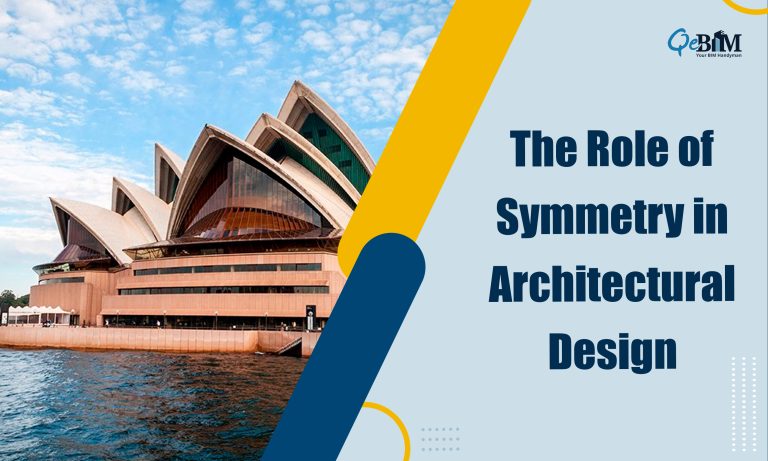The Role of Symmetry in Architectural Design

Introduction
In the realm of architecture, the interplay of form and function often culminates in structures that not only serve practical purposes but also captivate the observer with their aesthetic appeal. One timeless design principle that has consistently stood the test of time is symmetry. Symmetry in architecture is more than just a visual harmony; it is a profound exploration of balance, proportion, and precision.
The below blog post will let you delve into the significance of symmetry in architecture and explore notable examples where elegance meets precision.
Understanding Symmetry in Architecture
Symmetry, derived from the Greek word “symmetria,” means proportionate and balanced arrangement. In architecture, symmetry is achieved through the arrangement and balance of elements on both sides of a central axis, fostering a feeling of equilibrium and harmony. Architects harness symmetry to imbue their creations with a pleasing aesthetic that resonates with human perception.
Types of Symmetry
- Bilateral Symmetry:
- In bilateral symmetry, a structure is duplicated along a central axis, where each side precisely mirrors the other. This type of symmetry is prevalent in classical architecture and is often associated with a sense of stability and order.
- Radial Symmetry:
- Radial symmetry originates from a central point, with elements extending outward in a circular or spiral arrangement. This type of symmetry is frequently found in structures such as domes and rotundas, emphasizing a central focal point.
- Translational Symmetry:
- Translational symmetry involves the repetition of elements along a linear axis, creating a rhythmic pattern. This form of symmetry is commonly employed in modern architecture, where a sequence of identical or similar elements establishes a sense of continuity.
The Elegance of Symmetry
- Parthenon, Athens:
- One of the most iconic examples of bilateral symmetry is the Parthenon in Athens, Greece. Constructed in the 5th century BCE, this ancient temple dedicated to the goddess Athena exemplifies classical Greek architecture. The evenly spaced columns, identical on both sides, contribute to a harmonious and balanced aesthetic, showcasing the enduring allure of symmetry.

- One of the most iconic examples of bilateral symmetry is the Parthenon in Athens, Greece. Constructed in the 5th century BCE, this ancient temple dedicated to the goddess Athena exemplifies classical Greek architecture. The evenly spaced columns, identical on both sides, contribute to a harmonious and balanced aesthetic, showcasing the enduring allure of symmetry.
- Taj Mahal, Agra:
- The Taj Mahal, recognized as a UNESCO World Heritage Site and a prime example of Mughal architecture, showcases bilateral symmetry in its architectural design. The mausoleum is perfectly symmetrical along its central axis, with the majestic dome and minarets creating a visually stunning reflection in the surrounding pools. This symmetry not only imparts a sense of grandeur but also symbolizes the balance and harmony inherent in Mughal artistry.

- The Taj Mahal, recognized as a UNESCO World Heritage Site and a prime example of Mughal architecture, showcases bilateral symmetry in its architectural design. The mausoleum is perfectly symmetrical along its central axis, with the majestic dome and minarets creating a visually stunning reflection in the surrounding pools. This symmetry not only imparts a sense of grandeur but also symbolizes the balance and harmony inherent in Mughal artistry.
Precision in Symmetry
- Sydney Opera House, Australia:
- Jørn Utzon’s masterpiece, the Sydney Opera House, showcases a unique blend of modern design and precision symmetry. The iconic shell-like structures on the roof are meticulously arranged to create a sense of balance. The interplay of light and shadow on the sculpted surfaces enhances the precision of the architectural detailing, elevating the building to a work of art.

- Jørn Utzon’s masterpiece, the Sydney Opera House, showcases a unique blend of modern design and precision symmetry. The iconic shell-like structures on the roof are meticulously arranged to create a sense of balance. The interplay of light and shadow on the sculpted surfaces enhances the precision of the architectural detailing, elevating the building to a work of art.
- Burj Khalifa, Dubai:
- The Burj Khalifa, the world’s tallest skyscraper, is a testament to the application of translational symmetry in contemporary architecture. The repetition of modular elements in the façade creates a sleek and streamlined appearance with the help of accurate Façade BIM Services, emphasizing the precision required in the construction of such towering structures. The meticulous alignment of windows and setbacks contributes to the overall sense of visual coherence.

- The Burj Khalifa, the world’s tallest skyscraper, is a testament to the application of translational symmetry in contemporary architecture. The repetition of modular elements in the façade creates a sleek and streamlined appearance with the help of accurate Façade BIM Services, emphasizing the precision required in the construction of such towering structures. The meticulous alignment of windows and setbacks contributes to the overall sense of visual coherence.
Conclusion
Symmetry in architecture transcends mere aesthetic appeal; it is a fundamental principle that fosters a deep connection between the built environment and the observer. Whether in the classical columns of the Parthenon, the majestic symmetry of the Taj Mahal, or the contemporary precision of the Sydney Opera House and Burj Khalifa, symmetry continues to be a guiding force in architectural design and this can be achieved with accurate Architectural Drafting Services. As architects navigate the ever-evolving landscape of design trends and technologies, the enduring allure of symmetry remains a testament to its timeless elegance and the precision it brings to the architectural world.



